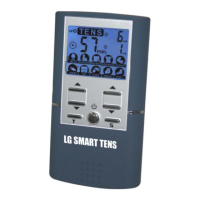carotid sinus reflex.
8) Stimulation should not be applied over the anterior neck or
mouth. Severe spasm of the laryngeal and pharyngeal muscles
may occur and the contractions may be strong enough to close
the airway or cause difficulty in breathing.
9) Stimulation should not be applied transthoracically in that the
introduction of electrical current into the heart may cause
cardiac arrhythmias.
10) Stimulation should not take place while the user is
connected to high-frequency surgical equipment, it may
cause burn injuries on the skin under the electrodes, as well
as problems with the stimulator.
11) Do not use the stimulator in the vicinity of shortwave or
microwave therapy equipment, since this may affect the
output power of the stimulator.
12) Never use in environments with high humidity such as in the
bathroom or when having a bath or shower.
13) Caution should be used in applying electrical stimulation to
patients suspected of having heart disease. Further clinical
data is needed to show there are no adverse results.
14) Never use near the heart. Stimulation electrodes should
never be placed anywhere on the front of the thorax
(marked by ribs and breastbone), but above all not on the
two large pectoral muscles. Here it can increase the risk of
ventricular fibrillation and lead to cardiac arrest.
15) Electrodes should not be placed over the eyes, in the mouth,
near the genitals or internally.
16) Never use on the areas of the skin which lack normal
sensation.
17) Apply the electrodes to clean, dry, and unbroken skin only.
18) Keep electrodes separate during treatment, electrodes in
contact with other could result in improper stimulation or skin
burns.
19) Keep the stimulator out of reach of children.
20) Consult your doctor if you are in any doubt whatsoever.
7

